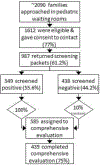Prevalence and Co-Occurrence of Developmental and Emotional-Behavioral Problems in Young Children
- PMID: 36417968
- PMCID: PMC10149553
- DOI: 10.1016/j.acap.2022.11.008
Prevalence and Co-Occurrence of Developmental and Emotional-Behavioral Problems in Young Children
Abstract
Objective: A limited number of studies have estimated the prevalence of emotional-behavioral disorders among young children. None have assessed their co-occurrence with developmental delays using standardized assessment tools. Our objective was to estimate the prevalence of emotional-behavioral disorders and their co-occurrence with developmental delays among young children (2-5.5 years).
Methods: Parents of young children (N = 987) enrolled from pediatric waiting rooms completed developmental-behavioral screening questionnaires. Based on results, 585 families were invited to and 439 completed evaluations that included structured diagnostic interviews with parents to assess child psychopathology (Preschool Age Psychiatric Assessment (PAPA)), developmental testing with children (including the Bayley Scales of Infant and Toddler Development, third Edition for children ≤ 42 months; Differential Ability Scales, second Edition for older children), and videotaped observation to establish whether autism risk was sufficient to warrant further evaluation.
Results: According to PAPA algorithms, 23.0% of children met criteria for a DSM-IV disorder, while 9% qualified for a developmental delay. Presence of delay doubled the odds of having a DSM-IV disorder (OR = 2.1; CI: 1.02-4.3), and presence of disorder doubled the odds of having a moderate-to-severe developmental delay (OR=2.0; CI: 1.10-3.50). Prevalence of DSM-IV disorders (48.8% (95% CI: 33.5-64.5%)) and developmental delays (57.5% (95% CI: 41.7-71.9%)) were both higher among children at risk for autism. While developmental delay did not vary by race/ethnicity, prevalence of DSM-IV disorders was lower among African-American/Black (10.6%; CI: 2.9-18.3) and Hispanic/Latino children (11.1%; CI: 4.3-17.9).
Conclusions: Developmental delays and emotional-behavioral disorders among young children seen in pediatric settings are characterized by high prevalence and substantial co-occurrence.
Keywords: comorbidity; developmental disabilities; prevalence; psychopathology.
Copyright © 2022 Academic Pediatric Association. Published by Elsevier Inc. All rights reserved.
Conflict of interest statement
Conflict of Interest Disclosures (includes final disclosures)
The authors have no financial conflicts of interest to report. Authors from Tufts Medical Center received funding to support this research. Outcomes reported include data from the Survey of Wellbeing of Young Children, which was co-developed by R. Christopher Sheldrick and is available free of charge.
References
-
- Costello EJ, Edelbrock C, Costello AJ, Dulcan MK, Burns BJ, Brent D. Psychopathology in pediatric primary care: the new hidden morbidity. Pediatrics 1988;82:415–424 - PubMed
-
- Haggerty RJ, & Friedman SB (2003). History of developmental-behavioral pediatrics. Journal of Developmental & Behavioral Pediatrics, 24, S1–S18 - PubMed
-
- Cicchetti D (1984). The emergence of developmental psychopathology. Child Development, 1–7. - PubMed
-
- Bright Futures/American Academy of Pediatrics. Recommendations for Preventive Pediatric Health Care Accessed online, August 16, 2022: https://downloads.aap.org/AAP/PDF/periodicity_schedule.pdf?_ga=2.2287110...
-
- Egger HL & Angold A. The Preschool Age Psychiatric Assessment (PAPA): A structured parent interview for diagnosing psychiatric disorders in preschool children. Handbook of infant, toddler, and preschool mental health assessment 2004; 223–243.
Publication types
MeSH terms
Grants and funding
LinkOut - more resources
Full Text Sources
Miscellaneous


